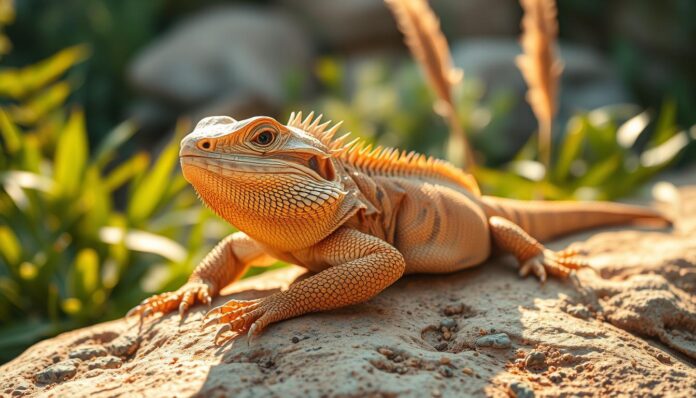Did you know bearded dragons need the sun for warmth? In their homes, we must provide the right warmth for their health. Providing the right basking conditions is key for their well-being.
Creating a optimal basking environment is more than just heat. It’s about making their home like their natural habitat. This means setting the right temperature and basking time, which is crucial for their care.
By understanding and setting up optimal basking conditions, we can make our bearded dragons happier and healthier.
The Science Behind Bearded Dragon Basking
Basking is key for bearded dragons. It helps them control their thermoregulation, metabolism, and health. Since they are ectothermic, they need outside heat to keep their body temperature right.
Thermoregulation and Metabolic Functions
Bearded dragons bask to get the right body temperature. This is important for their metabolic processes. Thermoregulation lets them have the energy for daily tasks like eating, breeding, and playing.
A good temperature range helps them digest food well. This keeps them healthy.
Natural Basking Behavior in the Wild
In the wild, bearded dragons bask in sunlight. They often do this on rocks or branches. This natural basking behavior is vital for their survival.
It helps them keep their body temperature in check. Watching how they bask in the wild helps us create a good environment for them at home.
The Role of Basking in Digestion
Basking is important for bearded dragons’ digestion. By basking, they keep their body temperature right for digesting food. Proper digestion is key for absorbing nutrients.
This affects their growth, energy, and health. Without enough basking, they might have digestion problems.
Key aspects of bearded dragon basking include:
- Regulation of body temperature
- Support for metabolic functions
- Enhancement of digestion
Knowing these points is important for keeping bearded dragons happy and healthy at home.
Bearded Dragon Basking Habits: What Owners Need to Know
It’s key to know about bearded dragon basking habits for a healthy home. They have specific daily basking patterns and behaviors. Owners need to understand these to help their pets thrive.
Daily Basking Patterns and Behaviors
Bearded dragons bask in the morning and early afternoon when the sun is brightest. In captivity, they seek out heat sources at these times. Owners can see their dragons change their basking spots to get more heat.
Daily basking patterns follow their natural circadian rhythm. A consistent temperature gradient and lighting schedule help regulate their behavior.
How to Interpret Your Dragon’s Basking Positions
A bearded dragon’s basking position shows its comfort with the temperature. If it basks with its mouth open, it’s trying to regulate its body temperature. If it avoids the basking spot, it might find it too hot or uncomfortable.
Watching these behaviors helps owners adjust the temperature and lighting. This ensures their pet’s needs are met.
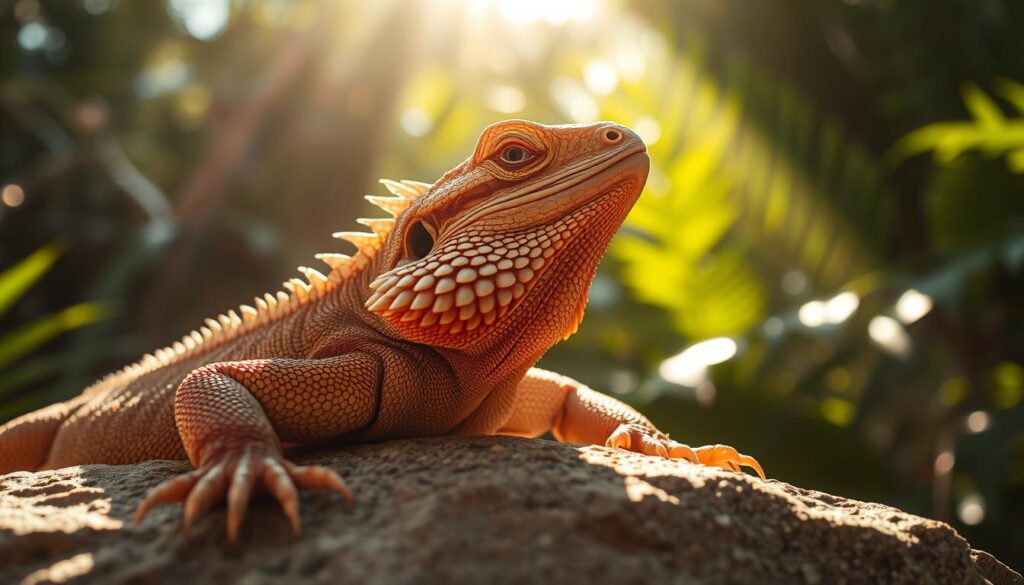
Age-Related Changes in Basking Needs
Younger bearded dragons need more frequent basking to support their growth. As they get older, their basking needs change. Older dragons may need less intense heat. Understanding these age-related changes is crucial for the right environment.
By recognizing these changes, owners can adjust their care routines. This ensures their bearded dragons stay healthy throughout their lives.
Ideal Basking Temperatures for Optimal Health
Bearded dragons need specific basking temperatures to stay healthy. Knowing these needs is key to their care. The right temperature range helps with their metabolism, digestion, and overall health.
Temperature Requirements by Age Group
The temperature needs of bearded dragons change with age. It’s important to understand these needs for the best care.
Baby Bearded Dragons (0-6 months)
Baby bearded dragons need basking temperatures between 95°F to 100°F (35°C to 38°C). This helps them grow fast and develop well.
Juvenile Bearded Dragons (6-18 months)
As they grow, juvenile bearded dragons need slightly cooler temperatures. They should bask between 90°F to 95°F (32°C to 35°C).
Adult Bearded Dragons (18+ months)
Adult bearded dragons prefer basking temperatures between 85°F to 90°F (29°C to 32°C). This supports their health and maintenance.
| Age Group | Basking Temperature Range (°F) | Basking Temperature Range (°C) |
|---|---|---|
| Baby (0-6 months) | 95-100 | 35-38 |
| Juvenile (6-18 months) | 90-95 | 32-35 |
| Adult (18+ months) | 85-90 | 29-32 |
Creating Proper Temperature Gradients
It’s important to have a temperature gradient in the enclosure. This lets bearded dragons adjust their body temperature. Use heat sources and cool spots for thermoregulation.
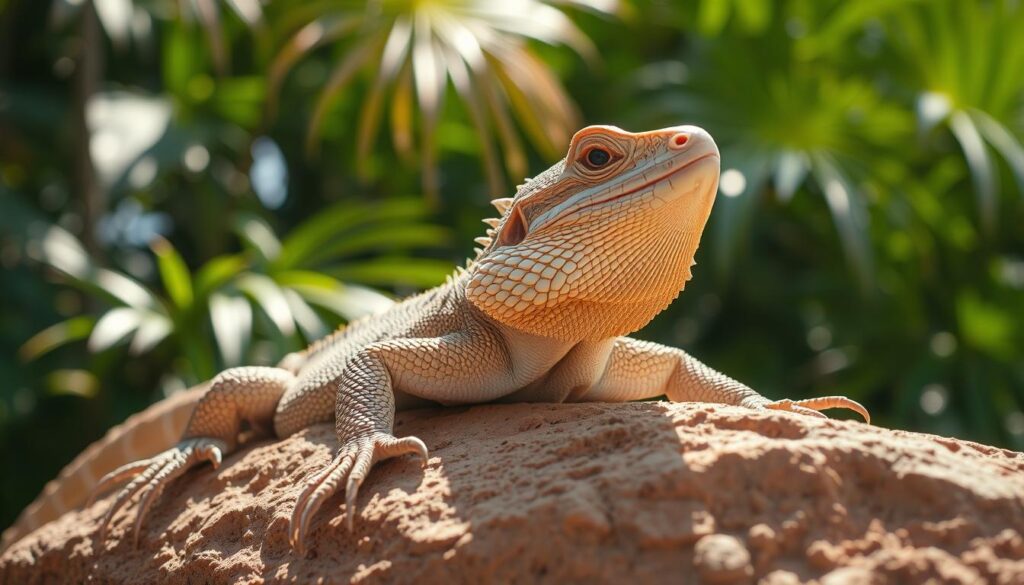
Tools for Measuring Basking Temperatures
It’s crucial to accurately measure basking temperatures. Digital thermometers and temperature guns help ensure the right temperatures for each age group.
Key Considerations: Always check the temperature gradient. Make sure it meets the bearded dragon’s needs. Adjust as needed to avoid overheating or underheating.
Setting Up the Perfect Basking Spot
Bearded dragons need a good basking area to stay healthy. A well-set basking spot is key for their well-being. It means picking the right platform, placing it right, and maybe setting up more basking areas.
Basking Platform Options and Materials
Choosing the right basking platform is important. You can pick from rocks, branches, or special basking platforms. Rocks are liked for their natural feel. The platform should be strong, easy to clean, and handle the heat from lamps.
- Rock structures for a natural look
- Branches for climbing and basking
- Commercial basking platforms for ease of use
Positioning Within the Enclosure
Where you put the basking spot matters a lot. It should have a temperature range so the dragon can move around. It should also not block hiding or eating spots.
Key considerations include:
- Creating a temperature gradient
- Avoiding direct competition with hiding and feeding areas
- Ensuring accessibility for the bearded dragon
Creating Multiple Basking Zones
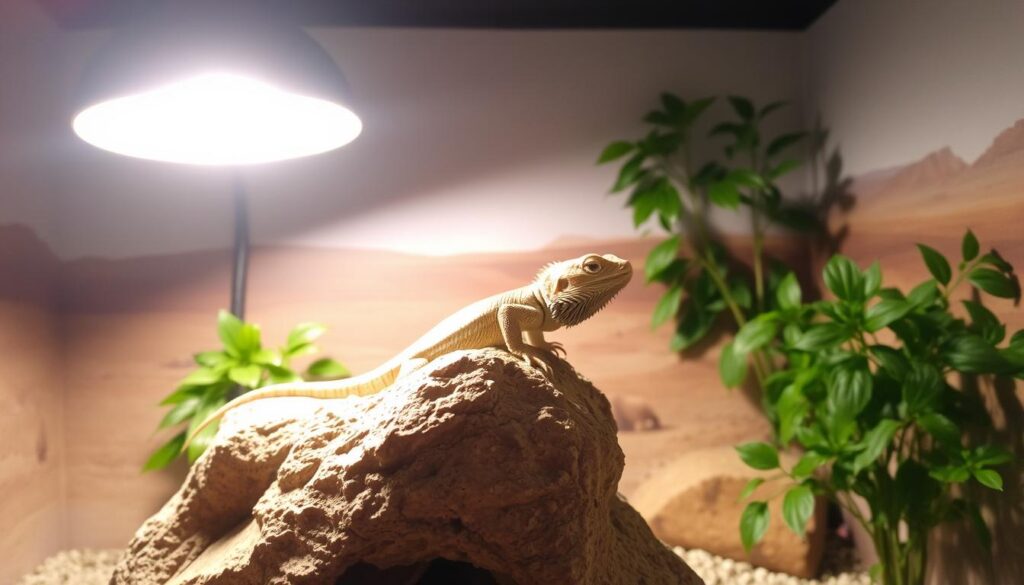
In big enclosures, having more basking spots is good. It lets the dragon pick its favorite spot and keeps the environment interesting. You can use more heat sources or different levels in the enclosure.
Designing a great basking spot improves your bearded dragon’s life a lot. It’s a big part of caring for them.
UVB Lighting: The Critical Component of Basking
UVB lighting is key for bearded dragon care. It affects their basking and health. It helps with calcium and prevents bone disease, making it vital for their home.
Intensity and Coverage Requirements
Bearded dragons need the right UVB light intensity and coverage. The light should be strong, like natural sunlight. It must also cover the whole basking area well.
Key considerations for UVB intensity and coverage include:
- UVB output: Make sure the bulb has enough UVB radiation.
- Distance: The UVB light should be at the right distance from the dragon’s spot.
- Surface area: The UVB light should cover the whole basking area.
| UVB Intensity Level | Recommended Distance | Coverage Area |
|---|---|---|
| High | 6-8 inches | Entire basking platform |
| Medium | 8-12 inches | Most of the enclosure |
| Low | 12+ inches | Limited areas |
Selecting the Right UVB Bulbs
Picking the right UVB bulb is crucial for bearded dragons. There are many types, like fluorescent and LED. Choose based on the dragon’s needs and the enclosure.
Bulb Placement and Replacement Schedule
Putting UVB bulbs in the right spot and replacing them often is important. The bulb should be far enough away to avoid overheating. This ensures the UVB light spreads evenly.
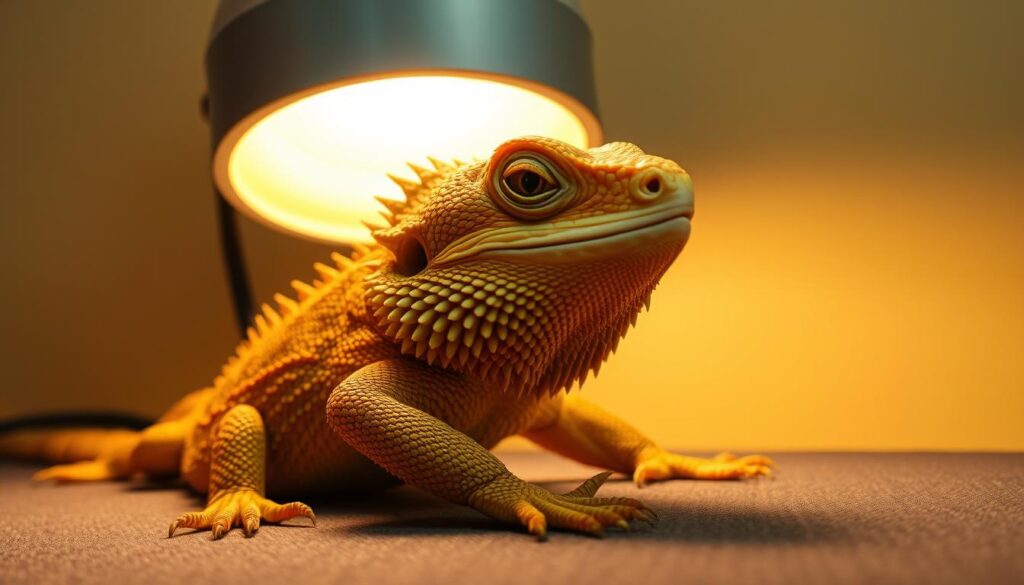
Best practices for bulb placement and replacement:
- Follow the manufacturer’s guidelines for placing the UVB bulb.
- Change UVB bulbs every 6-8 months because they lose strength over time.
- Watch the dragon’s health and adjust the UVB light as needed.
Heat Sources for Effective Basking Areas
Choosing the right heat sources is key for bearded dragons. They need the right heat to stay healthy and happy. This heat helps them feel like they’re in their natural home.
Types of Heat Lamps and Their Benefits
Bearded dragon owners have many heat lamp options. Ceramic heat emitters are great for nighttime because they only give off heat. Basking lamps offer both heat and light, like the sun.
These lamps are good because they focus the heat. This is important for a temperature gradient in the enclosure.
| Type of Heat Lamp | Benefits | Usage |
|---|---|---|
| Ceramic Heat Emitters | Produces heat without light | Ideal for nighttime use |
| Basking Lamps | Provides both heat and light | Simulates natural sunlight |
| Heat Mats | Provides gentle, consistent heat | Can be used in conjunction with other heat sources |
Mounting Options and Safety Considerations
When setting up heat sources, think about mounting options and safety. Heat lamps must be securely attached to avoid accidents. Clamp lamps or fixtures with a strong hold are good choices.
Also, keep the heat source away from the bearded dragon’s basking spot. This prevents overheating or burns.
Combining Heat Sources for Optimal Results
Using different heat sources can create the best basking conditions. For example, a basking lamp with a ceramic heat emitter can mimic day and night. It’s important to watch the temperature and adjust the heat sources as needed.
You May Like :- Kiwi for Bearded Dragons: Safe Snack or Risky Treat?
Optimizing Basking Duration and Scheduling
Bearded dragon owners know how key a good environment is. It must match their natural habitat. This includes the right basking duration and scheduling. The health and happiness of bearded dragons rely a lot on this.

Daily Basking Requirements
Bearded dragons need specific basking times each day to stay healthy. The time they bask depends on their age, size, and the environment. Usually, they need about 10-12 hours of basking daily. Younger dragons might need even more time and longer basking periods.
Creating a Day/Night Cycle
Setting up a day/night cycle is vital for basking. It means creating a lighting schedule that matches nature. This cycle should be 10-12 hours of light and 12-14 hours of dark. It helps keep their natural rhythms and promotes healthy behavior.
Seasonal Adjustments to Basking Schedules
Bearded dragons’ basking needs change with the seasons. In the wild, they adjust to temperature and sunlight changes. Owners must do the same in captivity by making seasonal adjustments to basking schedules.
In summer, they might need less intense basking. In winter, they might need more heat to stay warm. By making these changes, owners can help their pets stay healthy and happy.
Troubleshooting Common Basking Issues
Fixing basking problems is key to keeping bearded dragons healthy. Basking affects their metabolism, digestion, and health. It’s a big part of their daily life.
Signs Your Dragon Isn’t Getting Enough Heat
If your bearded dragon isn’t getting enough heat, it might seem tired, eat less, or move less. Checking temperature gradients in their home is important. This makes sure they have a good spot to bask.
Other signs include dull colors and looking unwell. It’s important to keep the basking area at the right temperature.
Recognizing Overheating and Heat Stress
Too much heat can harm your bearded dragon just like too little. Signs of too much heat include fast breathing, being very tired, or looking for cooler spots. It’s key to have a temperature range for your dragon to control its body heat.
Addressing Unusual Basking Behaviors
Strange basking habits, like staying too long or avoiding the basking area, might mean there’s a problem. It’s important to watch your bearded dragon’s behavior and change the basking area if needed.
How Basking Impacts Overall Bearded Dragon Health
A bearded dragon’s health is closely tied to its basking habits. Basking is more than just a behavior; it’s essential for their well-being. It affects many important bodily functions.
Connection Between Basking and Immune Function
Basking boosts a bearded dragon’s immune system. When they get enough heat and UVB light, they fight off diseases better. This makes them healthier overall.
Effects on Appetite and Digestion
Basking also affects a bearded dragon’s appetite and digestion. The right basking temperatures make them hungrier and help them digest food better. This ensures they get the nutrients they need to stay healthy.
Prevention of Common Health Issues
Good basking habits can prevent many health problems in bearded dragons. Issues like metabolic bone disease and respiratory infections are less likely. This helps them live longer, healthier lives.
In summary, basking is key to a bearded dragon’s health. It impacts their immune system, appetite, digestion, and risk of illness.
Conclusion: Maintaining Healthy Basking Routines
Keeping a healthy basking routine is key for your bearded dragon’s health. It’s important to understand why basking is crucial and how to set it up right. This helps your pet stay healthy and happy.
Creating a natural environment is essential. This means setting up the perfect basking spot and using the right UVB lighting. It also means keeping the temperature just right. This helps prevent health problems and keeps your pet thriving.
By following the tips in this article, you can give your bearded dragon the best care. Healthy basking routines are vital for their well-being. With the right knowledge, your pet can live a long and happy life.
FAQ
What is the ideal basking temperature for bearded dragons?
Bearded dragons need different basking temperatures at different ages. Young ones need a spot around 105-110°F (40-43.3°C). Adults prefer it a bit cooler, at 95-100°F (35-37.8°C). It’s important to have a temperature range so they can control their body heat.
How long should bearded dragons bask?
Bearded dragons usually bask for 8-12 hours a day. This happens mostly during the day. The exact time can change based on the dragon’s age and needs.
What type of UVB lighting is best for bearded dragons?
Bearded dragons need good UVB lighting. High-quality T5 HO (high output) UVB bulbs are best. They give off lots of UVB rays. Remember to replace the bulb every 6-8 months for the best results.
How often should I replace my bearded dragon’s UVB bulb?
You should replace the UVB bulb every 6-8 months. This keeps the UVB rays strong. It’s important for the dragon’s health and calcium metabolism.
What are the signs of inadequate heat for bearded dragons?
If your bearded dragon is not getting enough heat, you might see them being very tired or not wanting to eat. They might also bask too much or at the wrong times.
How can I create a temperature gradient in my bearded dragon’s enclosure?
To create a temperature gradient, use a heat source like a lamp or ceramic heater at one end. This lets the dragon move between warm and cool spots to keep its body temperature right.
What are the benefits of using a basking platform?
A basking platform is comfy and safe for your dragon. It also helps them act naturally. Plus, it lets you set up different basking areas in their enclosure.
How can I ensure my bearded dragon is getting enough UVB exposure?
Make sure the UVB bulb is 6-8 inches away from your dragon. Place it at an angle for even coverage. This way, your dragon can move around in the UVB zone.
What are the risks of overheating for bearded dragons?
Overheating can be very dangerous. It can cause dehydration, tiredness, and even death. Keep a close eye on the temperature and make sure the enclosure has good air flow.
How can I adjust my bearded dragon’s basking schedule seasonally?
Bearded dragons might need different basking times in different seasons. For example, they might bask less in winter and more in summer. Learn what your dragon needs to adjust their basking schedule.


